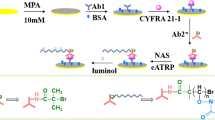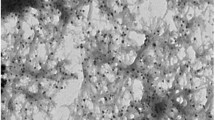Abstract
The concentration level of cytokeratin fragment antigen 21-1 (CYFRA21-1) can be used as an important indicator for predicting non–small cell lung cancer (NSCLC). Here, a sandwich-type electrochemical immunosensor for ultrasensitive detection of CYFRA21-1 is developed. The sensor based on a combination of gold nanoparticle (AuNPs) decorated Ti3C2Tx-MXene (Au-Ti3C2Tx) as the substrate enhancer, and toluidine blue (TB) modified AuNPs doped covalent organic framework (COF) polymer as the signal tag (TB-Au-COF). The Au-Ti3C2Tx is used to capture numerous primary antibodies and accelerate the electron transfer rate of the substrate, while the TB-Au-COF can be applied to provide a large number of signal units TB and secondary antibodies. These features of composites endow the proposed immunosensor with high sensitivity and current response to CYFRA21-1. Under optimum conditions, the immunosensor offers a wide current response for CYFRA21-1 from 0.5–1.0 × 104 pg·mL−1 with a detection limit of 0.1 pg·mL−1. Furthermore, the biosensing platform can be applied for CYFRA21-1 detection to analyze real serum samples, providing an effective and useful avenue for the applicability of Au-Ti3C2Tx and TB-Au-COF composite materials in biosensing field.






Similar content being viewed by others
References
Roointan A, Mir TA, Wani SI, Matiur R, Hussain KK, Ahmed B, et al. Early detection of lung cancer biomarkers through biosensor technology: a review. J Pharm Biomed Anal. 2019;164:93–103.
Zheng QF, Li JY, Yang L, Zheng B, Wang JC, Lv N, et al. Raman spectroscopy as a potential diagnostic tool to analyse biochemical alterations in lung cancer. Analyst. 2020;145(2):385–92.
Wang X, Zhang YW, Zhao LY, Wang DZ, Yang HX, Kong JM. Polysaccharide-enhanced ARGET ATRP signal amplification for ultrasensitive fluorescent detection of lung cancer CYFRA 21-1 DNA. Anal Bioanal Chem. 2020;412(11):2413–21.
Aberle DR, Adams AM, Berg CD, Black WC, Clapp JD, Fagerstrom RM, et al. Lung screening trial. Res N Engl J Med. 2011;365:395–409.
Pennell NA, Neal JW, Chaft JE, Azzoli CG, Janne PA, Govindan R, et al. SELECT: a phase II trial of adjuvant erlotinib in patients with resected epidermal growth factor receptor-mutant non-small-cell lung cancer. J Clin Oncol. 2019;37(7):97.
Altintas Z, Tothill I. Biomarkers and biosensors for the early diagnosis of lung cancer. Sens Actuators B. 2013;188:988–98.
Waseda R, Miyahara N, Moroga T, Wakahara J, Mei H, Yamamoto L, et al. Correlation between inflammatory markers and oncological outcomes in surgically resected non-small cell lung cancer. J Thorac Oncol. 2019;14:S704–4.
Li JG, Zhao LY, Wen DX, Li XF, Yang HX, Wang DZ, et al. Electrochemical CYFRA21-1 DNA sensor with PCR-like sensitivity based on AgNPs and cascade polymerization. Anal Bioanal Chem. 2020;412(11):4155–63.
Hu K, Cheng JM, Li JG, Ye S, Yang HX, Liu YJ, et al. Perfluorosulfonic acid polymer based eATRP for ultrasensitive detection of CYFRA21-1 DNA. Anal Methods. 2020;12(22):2827–34.
Lim DH, Lee JH, Kim JW. Feasibility of CYFRA 21-1 as a serum biomarker for the detection of colorectal adenoma and advanced colorectal adenoma in people over the age of 45. J Clin Lab Anal. 2018:32.
Kvas M, Teixeira AG, Chiang B, Frampton JP. Aqueous two-phase system antibody confinement enables cost-effective analysis of protein analytes by sandwich enzyme-linked immunosorbent assay with minimal optical crosstalk. Analyst. 2020;145(16):5458–65.
Chen ZH, Liang RL, Guo XX, Liang JY, Deng QT, Li M, et al. Simultaneous quantitation of cytokeratin-19 fragment and carcinoembryonic antigen in human serum via quantum dot-doped nanoparticles. Biosens Bioelectron. 2017;91:60–5.
Lan WJ, Lin YM, Men ZH, Yan L. Surface-decorated S-cerevisiae for flow cytometric array immunoassay. Anal Bioanal Chem. 2017;409(22):5259–67.
Xu YT, Xu L, Qiu MT, Wang J, Zhou Q, Xu L, et al. Prognostic value of serum cytokeratin 19 fragments (Cyfra 21-1) in patients with non-small cell lung cancer. Sci Rep. 2015;5:9444.
Yang GJ, Xiao ZQ, Tang CL, Deng Y, Huang H, He ZY. Recent advances in biosensor for detection of lung cancer biomarkers. Biosens Bioelectron. 2019;141:111416.
Sharifi M, Avadi MR, Attar F, Dashtestani F, Ghorchian H, Rezayat SM, et al. Cancer diagnosis using nanomaterials based electrochemical nanobiosensors. Biosens Bioelectron. 2019;126:773–84.
Zhang T, Ma N, Ali A, Wei Q, Wu D, Ren X. Electrochemical ultrasensitive detection of cardiac troponin I using covalent organic frameworks for signal amplification. Biosens Bioelectron. 2018;119:176–81.
Wang H, Zeng ZT, Xu P, Li LS, Zeng GM, Xiao R, et al. Recent progress in covalent organic framework thin films: fabrications, applications and perspectives. Chem Soc Rev. 2019;48(2):488–516.
Wang MH, Hu MY, Liu JM, Guo CP, Peng DL, Jia QJ, et al. Covalent organic framework-based electrochemical aptasensors for the ultrasensitive detection of antibiotics. Biosens Bioelectron. 2019;132:8–16.
Hu K, Cheng JM, Zhang WF, Pang TT, Wu XX, Zhang ZQ, et al. Simultaneous extraction of diverse organic pollutants from environmental water using a magnetic covalent organic framework composite. Anal Chim Acta. 1140(15):132–44.
Hu K, Cheng JM, Lu BB, Zhao WJ, Dong CH, Yang HX, et al. Magnetic mesoporous polyimide composite for efficient extraction of rhodamine B in food samples. J Sep Sci. 2019;42(11):2023–31.
Hu K, Shi YM, Zhu WX, Cai JL, Zhao WJ, Zeng HH, et al. Facile synthesis of magnetic sulfonated covalent organic framework composites for simultaneous dispersive solid-phase extraction and determination of β-agonists and fluoroquinolones in food samples. Food Chem. 2021;339:128079.
Mullangi D, Chakraborty D, Pradeep A, Koshti V, Vinod CP, Panja S, et al. Highly stable COF-supported Co/Co(OH)(2) nanoparticles heterogeneous catalyst for reduction of nitrile/nitro compounds under mild conditions. Small. 2018;14(37):1801233.
He J, Xu FJ, Chen Z, Hou XD, Liu Q, Long Z. AuNPs/COFs as a new type of SERS substrate for sensitive recognition of polyaromatic hydrocarbons. Chem Commun. 2017;53(80):11044–7.
Guo JX, Peng QM, Fu H, Zou GD, Zhang QR. Heavy-metal adsorption behavior of two-dimensional alkalization-intercalated MXene by first-principles calculations. J Phys Chem C. 2015;119(36):20923–30.
Kumar S, Lei YJ, Alshareef NH, Quevedo-Lopez MA, Salama KN. Biofunctionalized two-dimensional Ti3C2 MXenes for ultrasensitive detection of cancer biomarker. Biosens Bioelectron. 2018;121:243–9.
Norouzi S, Fakhrabadi MMS. Nanomechanical properties of single- and double-layer graphene spirals: a molecular dynamics simulation. Appl Phys A Mater Sci Process. 2019;125(5):321.
Kim SJ, Koh HJ, Ren CE, Kwon O, Maleski K, Cho SY, et al. Metallic Ti3C2TX MXene gas sensors with ultrahigh signal-to-noise ratio. ACS Nano. 2018;12(2):986–93.
Medetalibeyoglu H, Beytur M, Akyildirim O, Atar N, Yola ML. Validated electrochemical immunosensor for ultra-sensitive procalcitonin detection: carbon electrode modified with gold nanoparticles functionalized sulfur doped MXene as sensor platform and carboxylated graphitic carbon nitride as signal amplification. Sensors Actuators B Chem. 2020;319:128195.
Rasheed PA, Pandey RP, Jabbar KA, Ponraj J, Mahmoud KA. Sensitive electrochemical detection of l-cysteine based on a highly stable Pd@Ti3C2Tx (MXene) nanocomposite modified glassy carbon electrode. Anal Methods. 2019;11(30):3851–6.
Wu Q, Li NB, Wang Y, Liu Y, Xu YC, Wei ST, et al. A 2D transition metal carbide MXene-based SPR biosensor for ultrasensitive carcinoembryonic antigen detection. Biosens Bioelectron. 2019;144:111697.
Jiang YZ, Liu CY, Huang AS. EDTA-functionalized covalent organic framework for the removal of heavy-metal ions. ACS Appl Mater Interfaces. 2019;11(35):32186–91.
Huang RM, Chen SS, Yu JG, Jiang XY. Self-assembled Ti3C2/MWCNTs nanocomposites modified glassy carbon electrode for electrochemical simultaneous detection of hydroquinone and catechol. Ecotoxicol Environ Saf. 2019;184:109619.
Song DD, Jiang XY, Li YS, Lu X, Luan SR, Wang YZ, et al. Metal-organic frameworks-derived MnO2/Mn3O4 microcuboids with hierarchically ordered nanosheets and Ti3C2 MXene/AuNPs composites for electrochemical pesticide detection. J Hazard Mater. 2019;373:367–76.
Kandambeth S, Mallick A, Lukose B, Mane MV, Heine T, Banerjee R. Construction of crystalline 2D covalent organic frameworks with remarkable chemical (acid/base) stability via a combined reversible and irreversible route. J Am Chem Soc. 2012;134(48):19524–7.
Stackelberg MV, Pilgram M, Toome V. Bestimmung von Diffusionskoeffizienten einiger Ionen in wäßriger Lösung in Gegenwart von Fremdelektrolyten. I. Zeitschrift für Elektrochemie. 1953;57(5):342–50.
Zeng Y, Bao J, Zhao YN, Huo DQ, Chen M, Qi YL, et al. A sandwich-type electrochemical immunoassay for ultrasensitive detection of non-small cell lung cancer biomarker CYFRA21-1. Bioelectrochemistry. 2018;120:183–9.
Pachauri N, Dave K, Dinda A, Solanki PR. Cubic CeO2 implanted reduced graphene oxide-based highly sensitive biosensor for non-invasive oral cancer biomarker detection. J Mater Chem B. 2018;6(19):3000–12.
Meng XY, Chen X, Wu WH, Zheng W, Deng HH, Xu LY, et al. Electrochemiluminescent immunoassay for the lung cancer biomarker CYFRA21-1 using MoOx quantum dots. Microchim Acta. 2019;186(12):855.
Wang HQ, Ma ZF. “Off-on” signal amplification strategy amperometric immunosensor for ultrasensitive detection of tumour marker. Biosens Bioelectron. 2019;132:265–70.
Yang ZH, Zhuo Y, Yuan R, Chai YQ. Electrochemical activity and electrocatalytic property of cobalt phthalocyanine nanoparticles-based immunosensor for sensitive detection of procalcitonin. Sensors Actuators B Chem. 2016;227:212–9.
Funding
This study was supported by the National Natural Science Foundation of China (21605042 and 21974068), Key Science and Technology Research Project of Henan Province (192102310033), and Training Plan for Young Backbone Teachers in Universities of Henan Province (2020GGJS105).
Author information
Authors and Affiliations
Corresponding authors
Ethics declarations
Ethics approval
All procedures followed were in accordance with the ethical standards of the responsible committee on human experimentation (institutional and national) and with the Helsinki Declaration of 1975, as revised in 2008 (5). Informed consent was obtained from all patients for being included in the study. The serum was provided by the Third Affiliated Hospital of Henan University of Traditional Chinese Medicine, and approved by the Ethics Committee of Henan Province Hospital of Traditional Chinese Medicine, with the ethical code of 20200806-01.
Conflict of interest
The authors declare no conflicts of interest.
Additional information
Publisher’s note
Springer Nature remains neutral with regard to jurisdictional claims in published maps and institutional affiliations.
Supplementary Information
ESM 1
(PDF 500 kb)
Rights and permissions
About this article
Cite this article
Cheng, J., Hu, K., Liu, Q. et al. Electrochemical ultrasensitive detection of CYFRA21-1 using Ti3C2Tx-MXene as enhancer and covalent organic frameworks as labels. Anal Bioanal Chem 413, 2543–2551 (2021). https://doi.org/10.1007/s00216-021-03212-y
Received:
Revised:
Accepted:
Published:
Issue Date:
DOI: https://doi.org/10.1007/s00216-021-03212-y




